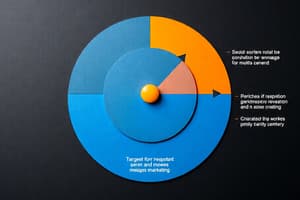Podcast
Questions and Answers
Which of the following is a basis for behavioral segmentation?
Which of the following is a basis for behavioral segmentation?
- Benefits sought (correct)
- Lifestyle choices
- Geographic location
- Age and gender
What is an example of geodemographic segmentation?
What is an example of geodemographic segmentation?
- Targeting based on loyalty to a brand
- Targeting based on urban versus rural residence (correct)
- Targeting based on age and income
- Targeting based on lifestyle preferences
What defines consumer lifestyles in psychographic segmentation?
What defines consumer lifestyles in psychographic segmentation?
- Brand loyalty and usage rates
- Personality traits and social class (correct)
- Income level and age group
- Geographic location and religion
Which market segmentation strategy involves targeting a single, specific segment?
Which market segmentation strategy involves targeting a single, specific segment?
What does behavioural segmentation primarily examine?
What does behavioural segmentation primarily examine?
In which segmentation strategy would a company target multiple segments with specific marketing mix for each segment?
In which segmentation strategy would a company target multiple segments with specific marketing mix for each segment?
Which of the following is not a criterion for evaluating the attractiveness of a market segment?
Which of the following is not a criterion for evaluating the attractiveness of a market segment?
The process of dividing a market into distinct groups with similar needs is known as what?
The process of dividing a market into distinct groups with similar needs is known as what?
What does the term 'reachable' imply in market segmentation?
What does the term 'reachable' imply in market segmentation?
Which factor is essential for a segment to be considered 'substantial'?
Which factor is essential for a segment to be considered 'substantial'?
In the context of behavioral segmentation, what is a key characteristic to consider?
In the context of behavioral segmentation, what is a key characteristic to consider?
What is one important question to ask when evaluating the attractiveness of a market segment?
What is one important question to ask when evaluating the attractiveness of a market segment?
Which of the following best describes the importance of identifiable segments?
Which of the following best describes the importance of identifiable segments?
What characteristic distinguishes geodemographic segmentation from other forms of segmentation?
What characteristic distinguishes geodemographic segmentation from other forms of segmentation?
Why might a company choose to utilize consumer lifestyles in segmentation?
Why might a company choose to utilize consumer lifestyles in segmentation?
What is the significance of the segment being profitable?
What is the significance of the segment being profitable?
Which of the following describes psychographic segmentation?
Which of the following describes psychographic segmentation?
What is a primary characteristic of the 'Achievers' category in the VALS framework?
What is a primary characteristic of the 'Achievers' category in the VALS framework?
Which demographic factor is NOT typically used in demographic segmentation?
Which demographic factor is NOT typically used in demographic segmentation?
Which category in the VALS framework is characterized by a focus on living in the moment and seeking excitement?
Which category in the VALS framework is characterized by a focus on living in the moment and seeking excitement?
Which segmentation method involves categorizing consumers based on their lifestyle and interests?
Which segmentation method involves categorizing consumers based on their lifestyle and interests?
What describes 'Survivors' in the VALS categories?
What describes 'Survivors' in the VALS categories?
Which characteristic is primarily associated with 'Makers' in the VALS framework?
Which characteristic is primarily associated with 'Makers' in the VALS framework?
How can a marketer best utilize geodemographic segmentation?
How can a marketer best utilize geodemographic segmentation?
What is the main advantage of using census data for market segmentation?
What is the main advantage of using census data for market segmentation?
Which of the following best defines behavioral segmentation?
Which of the following best defines behavioral segmentation?
Flashcards
Segmentation Bases
Segmentation Bases
Characteristics used to divide a market into distinct groups of customers.
Geographic Segmentation
Geographic Segmentation
Dividing the market based on location (countries, regions, cities, etc.).
Demographic Segmentation
Demographic Segmentation
Dividing the market based on age, gender, income, education, occupation, and other measurable characteristics.
Psychographic Segmentation
Psychographic Segmentation
Signup and view all the flashcards
Behavioral Segmentation
Behavioral Segmentation
Signup and view all the flashcards
Targeting Strategies
Targeting Strategies
Signup and view all the flashcards
Undifferentiated Targeting
Undifferentiated Targeting
Signup and view all the flashcards
Positioning
Positioning
Signup and view all the flashcards
Household Income
Household Income
Signup and view all the flashcards
Attractiveness of Segments
Attractiveness of Segments
Signup and view all the flashcards
Identifiable Segment
Identifiable Segment
Signup and view all the flashcards
Unique Segment
Unique Segment
Signup and view all the flashcards
Reachable Segment
Reachable Segment
Signup and view all the flashcards
Marketing Mix
Marketing Mix
Signup and view all the flashcards
Average Household Income for a category
Average Household Income for a category
Signup and view all the flashcards
Substantial Segment
Substantial Segment
Signup and view all the flashcards
VALS Categories
VALS Categories
Signup and view all the flashcards
Innovators (VALS)
Innovators (VALS)
Signup and view all the flashcards
Thinkers (VALS)
Thinkers (VALS)
Signup and view all the flashcards
Achievers (VALS)
Achievers (VALS)
Signup and view all the flashcards
Believers (VALS)
Believers (VALS)
Signup and view all the flashcards
Strivers (VALS)
Strivers (VALS)
Signup and view all the flashcards
Experiencers (VALS)
Experiencers (VALS)
Signup and view all the flashcards
Makers (VALS)
Makers (VALS)
Signup and view all the flashcards
Study Notes
Chapter 6: Segmentation, Targeting, and Positioning
- This chapter examines the process of targeting specific market segments
- Learning Objectives:
- Describe bases marketers use for segmenting markets.
- Identify criteria for evaluating segment attractiveness.
- Explain various targeting strategies (undifferentiated, differentiated, concentrated, micromarketing).
- Describe positioning and execution by firms.
Segmentation, Targeting, & Positioning
- Who is the target market for SOCIAL LITE Vodka?
- Product location strategy
- Multiple segmentation strategies were employed
The Segmentation-Targeting-Positioning Process
- Step 1: Establish overall strategy or objectives (consistent with the mission statement or derived from mission and current state)
- Step 2: Segmentation bases (geography, demographics, psychographics, behavior)
- Step 3: Evaluate segment attractiveness (identifiable, reachable, substantial and profitable, responsive)
- Step 4: Select target market (assessment of attractiveness of the opportunity and organization's competencies)
- Step 5: Identify and develop positioning strategy (value, product attributes, benefits & symbolism, competition, market leadership)
Segmentation Bases
- Geographic: Continent, country, region, city, climate
- Demographic: Age, gender, income, education, occupation, family size, family life cycle, religion, ethnicity
- Psychographic: Lifestyle (Innovators, Thinkers, Achievers, Experiencers), personality/self-concept, social class
- Behavioral: Benefits sought, usage rate, loyalty
Geographic Segmentation
- Divide market into separate geographic units (countries, regions, provinces, cities, neighborhoods)
- Develop appropriate marketing programs
Demographic Segmentation
- Most common method to divide market into groups
- Basis for dividing based on: Gender, age, ethnic group, family lifecycle stage, household type, income, occupation, education, religion
- Census data is an excellent source of segmentation data
Psychographic Segmentation
- How consumers describe themselves: Self-values, self-concept, lifestyles
- Marketers use this to appeal to one's self-concept
VALS Types
- Identified using a questionnaire and a program
- Classifies consumers into segments like Innovators, Thinkers, Believers, Achievers, Strivers, Experiencers, Makers, and Survivors.
Behavioural Segmentation
- Includes benefits, occasion, usage rate, and loyalty.
Geodemographic Segmentation
- Uses a combination of geographic, demographic, and lifestyle characteristics to segment a market
- "Birds of a feather flock together"
Step 3: Evaluate Segment Attractiveness
- Identifiable: Knowing who is in the market and whether the segments are unique
- Reachable: Understanding what the product can do and how consumers will get to it.
- Substantial and Profitable: Evaluating the size and growth potential of the segments.
- Responsive: Ensuring that customers react positively.
Step 4: Select Target Market
- Target market selection is based on SWOT analysis
- Attractiveness of the opportunity
- Organization's competencies
Targeting Strategies
- Undifferentiated: One product/service for the whole market.
- Differentiated: Separate products/services for distinct market segments.
- Concentrated: Targeting one specific segment of the market
- Micromarketing (One-to-One): Tailored product/service for individual customer wants/needs.
Undifferentiated Targeting Strategy
- Product/service perceived to provide the same benefits to everyone
Differentiated Targeting Strategy
- Targeting several market segments with different offerings
Concentrated (Niche) Targeting Strategy
- Selecting a single, primary market segment and focusing all energies on providing a product to fit that segment's needs
Micromarketing
- Tailoring a product/service to an individual customer's needs
Step 5: Identify & Develop Positioning Strategy
- Methods
- Value
- Product attributes
- Benefits & symbolism
- Competition
- Market leadership
Value
- Relates price to quality; different consumers have different value perceptions.
Product Attributes
- Focuses on the attributes that are most important to the target market.
Benefits & Symbolism
- Emphasizes brand benefits and psychological meaning.
Competition
- Options
- Position against a specific competitor
- Position against an entire product classification
Positioning by Using Perceptual Mapping
- Steps
- Determine consumer perceptions
- Identify market's ideal points and size
- Identify competitors' positions
- Determine consumer preferences
- Select the position
- Monitor the positioning strategy
Repositioning
- Changing a brand's focus to adjust to target new markets or align core emphasis with changing market preferences.
Studying That Suits You
Use AI to generate personalized quizzes and flashcards to suit your learning preferences.




